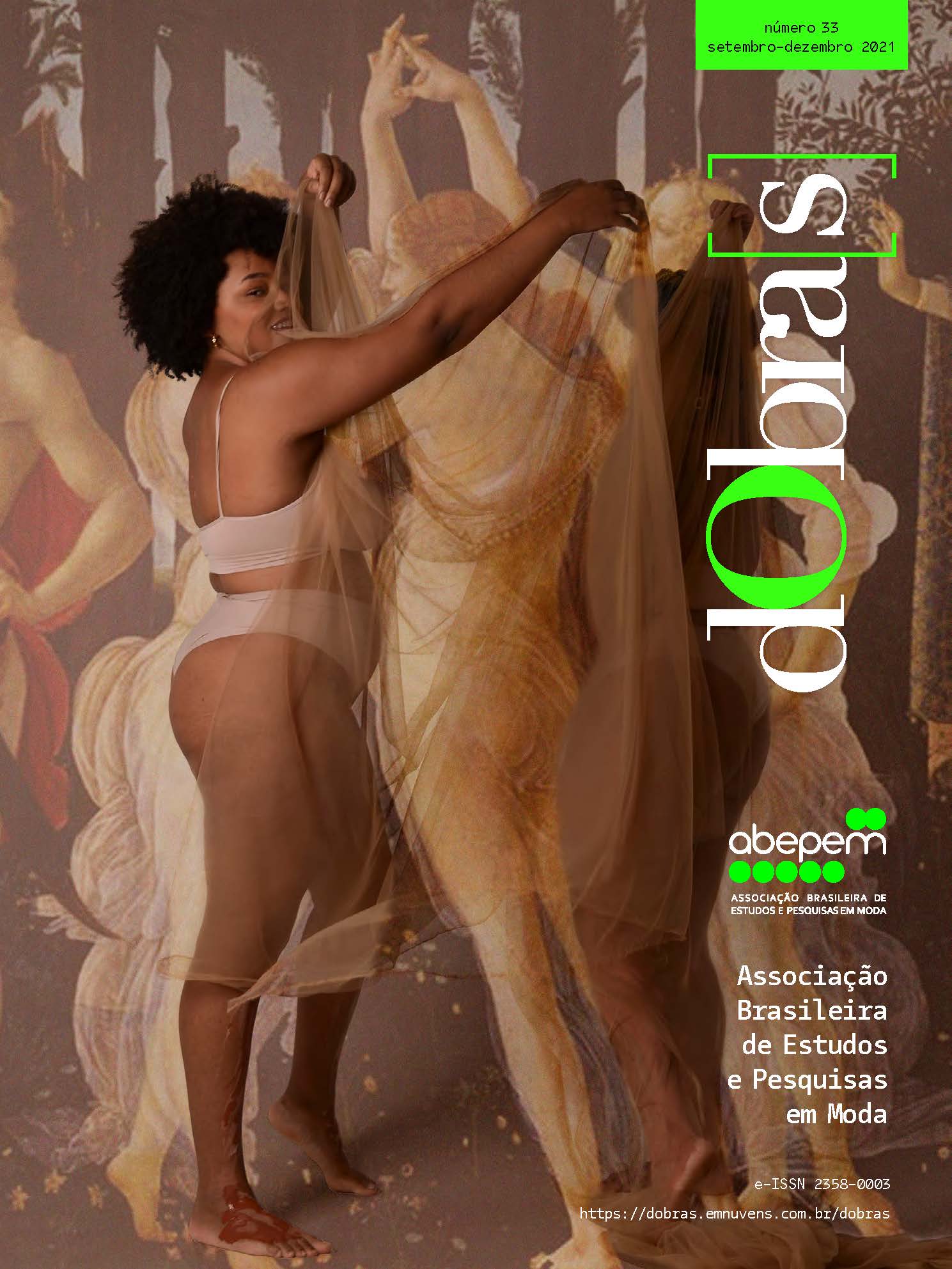Subaltern and marginalized
fat women and fashion on the covers of Donna magazine
DOI:
https://doi.org/10.26563/dobras.i33.1432Keywords:
Fat women, Donna magazine, Plus size fashion, Intersectionality, Place of speechAbstract
The objective is to analyze the inclusion of fat women on the covers of Donna magazine whose theme is fashion based on intersectionality, which considers gender crossed by the categories of race, class, sexuality, age group, aesthetics and disability. The corpus consists of ten Donna covers published in 27 years. As main findings are the fact that there is also, in the universe of representation of fat women, obedience to an aesthetic pattern, reproducing what is already naturalized in the universe of thin women: fat women are white, young, with smaller bodies. Thinking about a place of speech is essential to understand the space authorized by the magazine for fat women to occupy and what they are allowed to talk about. The analyzes reveal that in 80% of the covers, the place of speech of a fat woman implied the way in which she was portrayed as a reason for her presence, that is, the fat woman was due to the fact of being fat and was related to fashion in three main aspects: (a) specific fashion rules for their bodies, guiding what can and cannot be used; (b) the plus size fashion market, when there is a breach of previous rules related to traditional fashion and a celebration of the fat woman in fashion and, finally, (c) themes related to self-acceptance and self-love, not to mention plus size fashion - there is also the breaking of rules, but the centrality is not the fat nor the fashion, the latter appears as an important aid in the process of self-esteem.
Downloads
References
AIRES, Aliana Barbosa. De gorda à plus size: a produção biopolítica do corpo nas culturas do consumo – entre Brasil e EUA. 2019. 233f. Tese (Doutorado em Comunicação e Práticas de Consumo) – Programa de Pós-Graduação em Comunicação e Práticas de Consumo, Escola Superior de Propaganda e Marketing (ESPM), São Paulo, SP, 2019.
AKOTIRENE, Carla. Interseccionalidade. São Paulo: Sueli Carneiro; Pólen, 2019.
ARRUZZA, Cinzia; BHATTACHARYA, Tithi; FRASER, Nancy. Feminismo para os 99%: um manifesto. Tradução Heci Regina Candiani. 1. ed. São Paulo: Boitempo, 2019.
BAUMAN, Zygmunt. Vida para consumo: a transformação das pessoas em mercadorias. Tradução Carlos Alberto Medeiros. Rio de Janeiro: Jorge Zahar, 2008.
BERTH, Joice. Empoderamento. São Paulo: Sueli Carneiro; Pólen, 2019.
______. Tokenismo e a Consciência Humana: uma prática covarde. Medium, 2018. Disponível em: https://bit.ly/2PqkjpZ. Acesso em: 16 abr. 2021.
BOGADO, Maria; HOLLANDA, Heloisa Buarque de. Rua. In: HOLLANDA, Heloisa Buarque de (org.). Explosão feminista – arte, cultura, política e universidade. São Paulo: Companhia das Letras, 2019.
BUITONI, Dulcília S. Mulher de papel: a representação da mulher pela imprensa feminina brasileira. 2. ed. São Paulo: Summus, 2009.
BUTLER, Judith. Corpos que pesam: sobre os limites discursivos do sexo. In: LOURO, Guacira Lopes (org.). O corpo educado: pedagogias da sexualidade. Tradução Tomaz Tadeu da Silva. 2, ed. Belo Horizonte: Autêntica, 2000.
CRENSHAW, Kimberlé. Documento para o encontro de especialistas em aspectos da discriminação racial relativos ao gênero. Revista Estudos Feministas, v. 10, n. 1, p. 175, 2002.
DAVIS, Angela. Mulheres, raça e classe. São Paulo: Boitempo, 2016.
DEL PRIORE, Mary. Corpo a corpo com a mulher: pequena história das transformações do corpo feminino no Brasil. São Paulo: Senac, 2000.
FELERICO, Selma. Do corpo desmedido ao corpo ultramedido: as narrativas do corpo na revista brasileira. 1. ed. Curitiba: Appris, 2018.
FISCHER, Rosa M. B. O dispositivo pedagógico da mídia: modos de educar na (e pela) TV. Educação e Pesquisa, São Paulo, v. 28, n. 1, p. 151-162, jan./jun. 2002.
HALL, Stuart. Cultura e representação. Rio de Janeiro: PUC-Rio; Apicuri, 2016.
HOLLANDA, Heloisa Buarque de. Introdução: O grifo é meu. In: HOLLANDA, Heloisa Buarque de (org.). Explosão feminista – arte, cultura, política e universidade. São Paulo: Companhia das Letras, 2019.
JIMENEZ, Maria Luisa. Gordofobia: injustiça epistemológica sobre corpos gordos. Epistemologias do Sul, v. 4, n. 1, p. 144-161, 2020.
KILOMBA, Grada. Plantarions Memories: Episodes of Everyday Racism. Münster: Unrast Verlag, 2010.
LORDE, Audre. Não existe hierarquia de opressão. In: HOLLANDA, Heloisa Buarque de (org.). Pensamento feminista: conceitos fundamentais. Rio de Janeiro: Bazar do Tempo, 2019. p. 234-237.
LUCA, Tania Regina. Imprensa feminina: mulher em revista. In: PINSKY, Carla B.; PEDRO, Joana M (Org). Nova história das mulheres no Brasil. São Paulo: Contexto, 2012. p. 447-468.
RANGEL, Natália Fonseca de Abreu. O ativismo gordo em campo: política, identidade e construção de significados. 2018. 162f. Dissertação (Mestrado em Sociologia Política) - Programa de Pós-graduação em Sociologia Política, Universidade Federal de Santa Catarina, Florianópolis, SC, 2018.
RIBEIRO, Djamila. Lugar de fala. São Paulo: Sueli Carneiro; Pólen, 2019.
ROSÁRIO, Nísia Martins do; DAMASCENO, Alex. A prescrição do corpo televisivo: interdição, autoria, repetição e trans-aparência. Revista Comunicação Midiática, n. 2, v. 9, p. 68-81, mai./ago., 2014.
SARDENBERG, Cecilia M B. Caleidoscópios de gênero: gênero e interseccionalidades na dinâmica das relações sociais. Mediações, Londrina, v. 20 n. 2, p. 56-96, jul./dez. 2015.
SPIVAK, Gayatri. Pode o subalterno falar? Belo Horizonte: UFMG, 2010.
WOLF, Naomi. O mito da beleza: como as imagens de beleza são usadas contra as mulheres. Rio de Janeiro: Rocco, 1992.
Downloads
Published
How to Cite
Issue
Section
License

This work is licensed under a Creative Commons Attribution-NonCommercial-ShareAlike 4.0 International License.
The copyrights of the works published in this journal belong to the author, and dObra[s] holds the rights of first publication. Due to their publication in this open access journal, any work here is free to use, with its own attributions, in educational and non-commercial applications.










